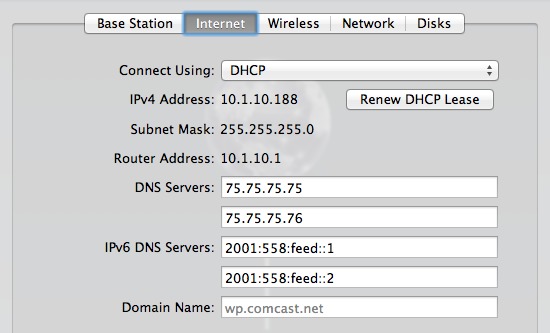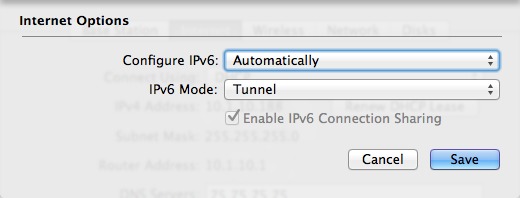Apple Restores IPv6 Support in AirPort Utility
IPv6 has returned to AirPort Utility by popular demand, a reversal of its removal in the recently released version 6.0. The next-generation addressing system for the Internet, which replaces the empty pool of familiar IPv4 numbers (of the pattern 192.168.0.1), is required for the Internet to continue functioning. ISPs, network hardware providers, content sites, search engines, and groups that form the backbone of the Internet’s infrastructure policy groups are all agreed.
The Internet Society (the folks behind the IETF and RFCs) even drew a worldwide line in the sand on 6 June 2012, not just to test IPv6 in a widespread fashion, as in previous years, but also to keep everything active from that point on and continue to expand the use of IPv6 for ordinary users, who shouldn’t have to sweat the details.
IPv6 is necessary because IPv4 simply doesn’t have enough addresses to encompass the many billions of devices that require Internet access — and that’s just today. In the future, every mote of smart dust might need an IP address. While NAT (Network Address Translation) enabled IPv4 to limp along for years, aided by a number of other behind-the-scenes tricks, IPv6’s vastly larger set of possible addresses (3.4 x 10^38) is the only real solution.
It has been over a decade since IPv6 became standardized, but 2012 is the year in which IPv6 has finally hit the flashpoint for adoption: IPv4 addresses are essentially exhausted (trading is still going on) and IPv6 infrastructure is ready but needs real-world commitment to bring about full operational equality with IPv4. Even if things break a little, IPv6 must be pushed forward. (The reason it has taken so long? There’s no financial reward, only a cost, in switching. It’s inevitable, but that money has to come out of somebody’s budget in every organization.)
That’s why it was so strange that Apple dropped IPv6 support in the housecleaning that resulted in AirPort Utility 6.0; the AirPort Utility iOS app never had it. While many of the features removed from AirPort Utility 6.0 impacted only network administrators, very few of whom use Apple Wi-Fi gear any more, IPv6 has a broader impact. Apple built it into Mac OS X years ago, and it has been fully supported in iOS from the start. Removing IPv6 support in AirPort Utility meant that broadband modems plugged into newly configured AirPort base stations couldn’t hand off IPv6 information to the base station nor to other devices on the same network. That’s a problem. (See “AirPort Utility 6.0
Adds iCloud Support but Removes Many Features,” 1 February 2012, for more details about the iOS app and the 6.0 changes.)
But IPv6 is back! On the heels of many WWDC announcements, including a quiet overhaul of the AirPort Express Base Station (see “AirPort Express Turned into Simultaneous Dual-Band Hockey Puck,” 11 June 2012), Apple released updated Mac OS X and iOS versions of AirPort Utility. The primary reason was to add support for simultaneous dual-band networking in the new AirPort Express, which appeared in AirPort Utility 5.6.1 for 10.6 Snow Leopard and 10.5 Leopard. (All 5.x versions of AirPort Utility include IPv6 configuration, and 5.x versions continue to work with all released AirPort base stations starting with 2003 models.)
[An aside here, since AirPort Utility’s version support seems confused in the 5.5 and 5.6 releases. In June 2011, Apple released AirPort Utility 5.5.3 for 10.6 Snow Leopard and 10.5 Leopard. This version continued to work under 10.7 Lion. Then on 30 January 2012, Apple released AirPort Utility 5.6 for Mac OS X 10.7.2 Lion, alongside AirPort Utility 6.0, which was also only for Lion. Fair enough. But the new AirPort Utility 5.6.1 no longer lists support for Lion, showing only 10.5.7 to 10.6.8 as supported versions. It’s confusing as all get out. If this is accurate, then Lion users must
download AirPort Utility 5.6.0 to configure now-missing options on existing AirPort base stations, and if you’re running Lion and get a new AirPort Express, which requires either AirPort Utility 6.1 or 5.6.1, those options removed in AirPort Utility 6.0 are just inaccessible.]
The updated AirPort Utility 6.1 for Lion and the revised AirPort Utility for iOS include support for the new AirPort Express, along with an Internet Options button added to the Internet view. The main Internet view now lets you enter IPv6-based DNS servers, necessary for resolving domain names to IPv6 addresses.
The Internet Options dialog includes a Configure IPv6 pop-up menu that lets you choose from Link-Local Only (use only on local network), Automatically (pick up via DHCP from the broadband connection, like an IPv4 address), or Manually (requires specific address entry).
For all but Link-Local Only, you can select Native or Tunnel, which refers to how the IPv6 connection is made. A native connection provides IPv6 service to all devices on the network; a tunneled connection encapsulates IPv6 traffic at the router and wraps it up to carry across an IPv4 segment of the network to reach a fully native IPv6 backbone. That’s a little technical, I know, but it might help you talk to your ISP or other service provider when trying to enable IPv6.
IPv6 isn’t the most exciting technology in the world. If you’re not involved in Internet infrastructure or IT, it’s like listening to sewer engineers talk about the kind of plastic used in outflow pipes. But IPv6 is a necessary part of making sure the Internet continues to work. The bits must flow!


Um, RFC, not RFP.
That is all.
Fixed, thanks!
Is it possible to have versions 6.1 and 5.6.1 both available?
When version 6.0 was released, I renamed the older version to Airport Utility 5.6 and had no problem. I installed version 6.1 via Software Update and then downloaded version 5.6.1 from the Apple website. It installs from an installer package and when I tried to run the installer, I was informed that the operating system (10.7.4) was not supported.
You can have both 6.x and 5.6.x versions installed. Renaming the older version is the problem. I would delete all the versions of AirPort Utility you have, and download the 5.6.1 and 6.1 installers and run them separately.
I tried to do what you suggested. I moved both versions to the Trash and then emptied the Trash. I then downloaded the new versions from the Apple website. I tried to install Version 5.6.1 but received the same error as before. I then installed 6.1 with no issues and restored version 5.6 from the Time Machine. So it appears that Apple really doesn't want Lion users to use version 5.6.1.
As a last resort, I used Pacifist to extract the 5.6.1 app from its package, installed it only desktop, renamed it and moved it to the Utilities folder.
I'm afraid I don't have any additional advice. It's probable that there are files installed in places that need to be removed, but I haven't heard of this problem before, so I don't know what they would be. I'd suggest trying Apple's user forums next, as you might find someone who has already sorted through this problem.
I'm surprised you haven't run into this problem as the download of Airport Utility 5.6.1 you link to in your article specifically indicates that it is for OS X 10.5.7 to 10.6.8. No mention of Lion (10.7.x).
Ah, yes, that's confusing. I will fix that. Apple updated 5.5 to 5.5.3 for Leopard and Snow Leopard back in January. The 5.6 release was for Lion only. Now 5.6.1 is for Leopard and Snow Leopard only, and you apparently can't run 5.6.1 under Lion.
Yes. Definitely starting to get a bit confusing. I'm considering getting one of the new express base stations to try out just so I can drop an old one that I use for AirPlay that is not supported by AP Utility 6.x
That and IPV6 support are most of the reason I still used AP Utility 5.6 (well that and I preferred the old interface but what can you do).
I've revised the article. The history is:
June 2011: 5.5.3 for Leopard/Snow Leopard.
January 2012: 5.6.0 for Lion, 6.0 for Lion.
June 2012: 5.6.1 for Leopard/Snow Leopard, 6.1 for Lion.
If my cable modem connects to my ISP using IPv6, and my Airport Extreme connects to the modem, would I need to use IPv6 on my LAN, which contains about a half dozen devices?
You don't have to use IPv6 on your local network. NAT in the router, which creates private addresses only used on the local network, can still assign out IPv4 addresses, even if the router were only routing using IPv6 to the ISP's network.
If you have an older Express (802.11g) set up for music as I do, you will need to keep a version of 5.6 for no other reason than to connect to it, as 6.1 will not read it.
"This version of AirPort Utility doesn't support this base station. Use AirPort Utility 5.6 to configure or manage this base station."
Thanks, Apple....!
Sorry, it's not clear to me what we users with a home AirPort network should be doing about IPv6. What settings should we be choosing in the Utility?
"Apple built it into Mac OS X years ago, and it has been
fully supported in iOS from the start. "
It still doesn't support v6 in iOS over 3G. It works ok over wifi only.